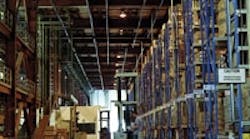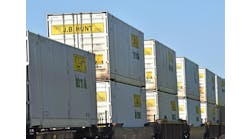Leaders in the warehouse-based third-party logistics (3PL) business in general are encouraged about the prospects for the economy and their industry in 2012, even if their optimism is tempered by the knowledge that events could prove those predictions wrong.
Although the industry has enjoyed the beginnings of a slow economic recovery from the 2008 crash, the financial crisis in Europe and the regulatory environment here at home make those who head warehouse firms wary. That tends to dampen job growth in the industry.
The Bright Side
“I would hope that the little bit of sunshine that is finally breaking through the dark clouds of the economy will continue, and if it does I would think that will really help in encouraging people to bring in more inventory,” says Ron Massman, president and CEO of The Dependable Companies (www.godependable.com), based in Los Angeles, which has 1.5 million square feet of warehouse space as well as separate less-than-truckload, truckload, drayage and international transportation management operations.
“I think a lot depends on the world economy and the perception that people have as to how the economic climate is going to be going forward,” he says. “My feeling is that we will see a steady growth throughout the year, barring any big dips and assuming the solutions in Europe will take hold.”
“In general we still forecast an upswing of double digits for the 3PL industry for next year,” says Paul Verst, president and CEO, Verst Group Logistics (www.verstgroup.com), Walton, Ky., which offers public contract warehousing, transportation and contract packaging services in the consumer packaged goods market, primarily for retail and food manufacturers and users, like Procter & Gamble and Kroger’s Supermarkets, as well as the automotive sector. “We are budgeting a 10-12% increase in sales for our company for next year.”
Arthur Barrett, president of Barrett Distribution Centers (www.barrettdistribution.com), Franklin, MA, says that overall he is more optimistic than he has been in the last several years. He notes that 2012 is being tagged as a year of “renovation and rebuilding.” His company offers warehouse, distribution and supply chain management services to a variety of industry segments, with a focus on retail.
“The economy has been stale for quite some time now and companies have been sitting on cash rather than spending it,” Barrett observes. “Previously, frozen budgets have enabled lost creativity and operational conservatism. This coming year, budgets will begin to thaw as companies begin to reinvest. We expect to see companies investing in their infrastructure (retirement plans, capital expenses and retention programs) with the goal of strengthening their internal systems to be poised for growth.”
Brett Mears, executive vice president of Palmer Logistics (www.palmerlogistics.com), a Houston-based company that serves the chemical industry, also is bullish. “I believe that the warehouse-based 3PL industry will continue to grow strongly in 2012. Lease rates are still depressed vis-à-vis the market high back in 2007-08, so the time is right to save significant dollars (10-25% lower space cost) on your brick-and-mortar expense.”
He adds, “Specific to Palmer Logistics, I think we are going to experience sustained growth on the order of what we have historically seen over the past two years of 10-20% as companies continue to look to outsourcing to reduce or control costs, and to allow them to focus upon their specific core competencies.”
The Not-So-Bright Side
This optimism is tempered by views of Don Friddell, director of marketing for Kenco Logistic Services, LLC (www.kencogroup.com), Chattanooga, Tenn., who predicts that growth will actually slow down in 2012. Kenco is one of the nation’s largest warehouse-based 3PLs, serving the consumer products, retail, building materials, automotive and healthcare industries with warehouse, transportation and supply chain management services. (It also owns Kenco Toyota Lift, with branches in Chattanooga, Tenn., Dalton, Ga., Madison, Ala., King of Prussia, Pa., Cinnaminson, N.J., and Baltimore.)
“We expect slower growth in 2012 because many companies remain concerned with the future of the overall economy,” Friddell says. “Many of our customers are not willing to make any major changes. They are maintaining the operational heads-down mentality.”
“In the 3PL industry as a whole I think you’ll see moderate growth, says Mark V. DeFabis, president and CEO, Integrated Distribution Services, Inc. (www.integrateddistributionservices.com), Plainfield, Ind., which provides warehousing, fulfillment, transportation and freight management services to companies serving the retail markets. In his portion of the market he sees a fairly mature warehousing industry.
“When you look at the big statistics, almost all the manufacturers and other companies that were thinking about outsourcing their warehousing have pretty much done it,” DeFabis says. “In the big picture, there are not a huge number of companies coming into the market space.”
E-Hope
One area where DeFabis foresees more robust growth is in the e-commerce retail segment on the fulfillment side of the direct-to-consumer market.
“I think that has a tremendous room for growth because for these companies to make it into the top 500 e-commerce companies in the U.S., you only have to do $20 million in sales,” he adds. “There is a lot of room for what I call fast-growing smaller to medium-sized companies who really understand that at some point they can’t continue to do their own fulfillment out of their garage or a rented self-storage unit. They are going to need a more professional approach to supply chain-related services.”
This prediction is borne out by recently completed research by Saddle Creek Corporation (www.saddlecrk.com) of Lakeland, Fla., which predicts that U.S. e-retail sales will grow by 10% a year to $279 billion by 2015, accounting for 11% of all retail sales.
Saddle Creek provides warehousing, transportation, contract packaging, fulfillment and logistics management services nationwide from 29 locations and 14 million square feet of warehouse space, serving a broad range of industries, including retail, grocery, beverage, alcohol and manufacturing.
In September and October of 2011 the company surveyed 160 e-commerce industry professionals who work for retailers, distributors and manufacturers—about 81% of whom were from the retail sector—and that survey resulted in an in-depth white paper examination of e-fulfillment trends.
“Of those who outsource, 65% say they anticipate their e-fulfillment outsourcing will increase substantially or somewhat in the next 12 to 24 months,” observes Jeff Jones, vice president, sales and marketing, for ProLog Logistics (www.prologlogistics.com), a Saddle Creek subsidiary. “The additional volume will be handled by a current partner for 56.1% of respondents, while 24.4% will seek a new partner and just 9.8% will handle it internally.”
The bottom line, he says, is that effective fulfillment will be vital for business success in e-commerce. “It is important to give your company every advantage. More and more companies are realizing the value that third-party providers can offer—in terms of counsel and expertise as well as depth of capabilities.”
One reason is that e-fulfillment is a holistic process where warehouse and inventory management, information systems, freight management and customer service must work together seamlessly, Jones explains.
“Providing effective order fulfillment in an e-commerce environment proves challenging for many companies,” Jones says. “The practice has evolved to a level of sophistication that requires carefully planned processes, scalable operations, state-of-the-art systems, and efficient transportation — all of which require extensive expertise and resources that can divert attention away from core competencies. Many companies recognize that they can better control costs, accommodate business growth, and ensure service excellence by outsourcing some or all of their fulfillment needs.”
(For a copy of the Saddle Creek white paper, “2011 E-Fulfillment Trends Report,” visit http://saddlecrk.com/whitepaper/welcome.asp).
The Workforce
Of course, the top-of-mind question regarding economic developments in 2012 is what will happen to the employment picture. In the warehouse industry, the view is encouraging in some respects, particularly when it comes to skilled workers, but the outlook is discouraging for unskilled manual labor in most cases. In fact many companies are searching hard for technological solutions that will help them reduce their workforces, largely because of competitive cost pressures and the uncertainty created by burgeoning government regulations and a fragile economy.
“I think almost everybody is going to be adding jobs, but they probably won’t be at the lowest end of the [skill] spectrum, the entry-level jobs,” says DeFabis. “There may be a few of those, but where I see a lot of emphasis coming and job growth is in the more skilled jobs, in particular, industrial engineers and other positions that can help with increasing productivity.”
High-Tech’s Promise
DeFabis adds, “There is increasing emphasis on getting those skills into the company that can look at our processes and procedures in our operations and find where we can re-engineer them, where can we put automation into place to become more efficient.”
This is a major priority at The Dependable Companies, according to Ron Massman. “We are implementing very sophisticated engineered time standard processes that will be rolled-in the first quarter, and with that we do anticipate an improvement in our efficiency and hopefully our ability to reduce labor on the manual side.
“As we grow, of course we will need more people but from a technology standpoint we’re looking to hold the line or reduce labor if at all possible and continue with our efforts to find better ways of doing things through technology.”
Don Friddell of Kenco says the same thing is a priority for his company. “We strongly support an engineered approach to the management of our business,” he adds. “We currently have 40 engineers at corporate and another 30 in the field to support our continuous improvement initiatives. Given the scarcity, we will continue to hire quality, skilled engineers in 2012.”
Paul Verst said his company is taking a broader approach to employment to deal with current and anticipated business growth. “We are in the process of hiring more IT support people, truck drivers and forklift operators along with customer service, middle management and sales personnel,” he says. “We already have industrial engineering capacity in house.”
Train to Retain
Arthur Barrett foresees some companies taking an entirely different approach by emphasizing retention through training and promoting from within. “Smart employers will focus on ‘re-recruiting and re-engaging’ their top talent through employee retention programs, incentive plans, career pathing, work family benefits, retirement programs, training and development in order to keep their top talent engaged,” he says.
He pointed out that the cost to replace an employee, which in past years was estimated at two to three times the cost of their annual salary, in 2012 will jump to five times annual salary stemming from the additional costs associated with hiring new employees, replacing and training them in specific skills, manager downtime, and employee strain to pick up the slack while the position is vacant.
David L. Sparkman is director of media and industry relations for the International Warehouse Logistics Association (www.iwla.com).



